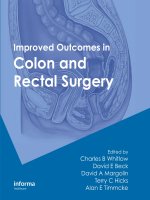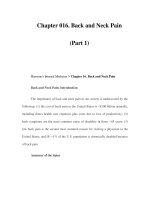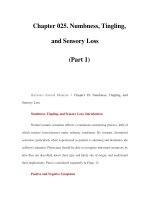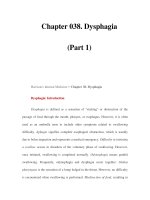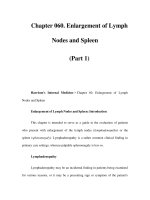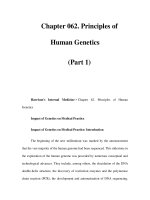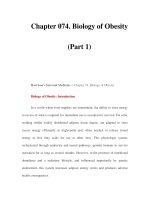ADVANCED PAEDIATRIC LIFE SUPPORT - part 1 ppsx
Bạn đang xem bản rút gọn của tài liệu. Xem và tải ngay bản đầy đủ của tài liệu tại đây (513.63 KB, 35 trang )
ADVANCED
PAEDIATRIC
LIFE SUPPORT
The Practical Approach
Third edition
Advanced Life Support Group
BMJ Books
ADVANCED
PAEDIATRIC
LIFE SUPPORT
The Practical Approach
Third edition
Advanced Life Support Group
Edited by
Kevin Mackway-Jones
Elizabeth Molyneux
Barbara Phillips
Susan Wieteska
BMJ Paediatrics 9/11/0 9:59 pm Page iii
© BMJ Books 1997, 2001
BMJ Books is an imprint of the BMJ Publishing Group,
BMA House, Tavistock Square, London WC1H 9JR
www.bmjbooks.com
All rights reserved. No part of this publication may be reproduced, stored in a retrieval
system, or transmitted, in any form or by any means electronic, mechanical, photocopying,
recording, and, or otherwise, without the prior written permission of the Advanced Life
Support Group.
First published in 1993 by the BMJ Publishing Group
Reprinted 1994
Reprinted 1995
Reprinted 1996
Second edition 1997
Reprinted 1998
Reprinted with revisions 1998
Reprinted 1999
Reprinted 2000
Third edition 2001
British Library Cataloguing in Publication Data
A catalogue record for this book is available from the British Library
ISBN 0-7279-1554-1
Typeset in Great Britain by FiSH Books, London
Printed and bound by Selwood Printing Ltd, Burgess Hill, West Sussex
BMJ Paediatrics 9/11/0 9:59 pm Page iv
CONTENTS
Working Group vii
Contributors ix
Preface to the Third Edition xi
Preface to the First Edition xiii
Acknowledgements xv
Contact Details and Website Information xvi
PART I: INTRODUCTION
Chapter 1 Introduction 3
Chapter 2 Why treat children differently? 7
Chapter 3 Recognition of the seriously ill child 13
PART II: LIFE SUPPORT
Chapter 4 Basic life support 21
Chapter 5 Advanced support of the airway and ventilation 35
Chapter 6 The management of cardiac arrest 45
Chapter 7 Resuscitation at birth 59
PART III: THE SERIOUSLY ILL CHILD
Chapter 8 The structured approach to the seriously ill child 71
Chapter 9 The child with breathing difficulties 79
Chapter 10 The child in shock 99
Chapter 11 The child with an abnormal pulse rate or rhythm 117
Chapter 12 The child with a decreased conscious level 127
Chapter 13 The convulsing child 139
Chapter 14 The poisoned child 149
BMJ Paediatrics 9/11/0 9:59 pm Page v
PART IV: THE SERIOUSLY INJURED CHILD
Chapter 15 The structured approach to the seriously injured child 161
Chapter 16 The child with chest injury 173
Chapter 17 The child with abdominal injury 179
Chapter 18 The child with trauma to the head 183
Chapter 19 The child with injuries to the extremities or the spine 191
Chapter 20 The burnt or scalded child 199
Chapter 21 The child with electrical injury or near drowning 205
PART V: PRACTICAL PROCEDURES
Chapter 22 Practical procedures – airway and breathing 213
Chapter 23 Practical procedures – circulation 221
Chapter 24 Practical procedures – trauma 233
Chapter 25 Interpreting trauma X-rays 243
Chapter 26 Transport of children 255
PART VI: APPENDICES
Appendix A Acid–base balance 263
Appendix B Fluid and electrolyte management 269
Appendix C Child abuse 281
Appendix D Childhood accidents and their prevention 291
Appendix E Dealing with death 295
Appendix F Management of pain in children 297
Appendix G Triage 303
Appendix H Envenomation 307
Appendix I Formulary 313
Index 330
vi
BMJ Paediatrics 9/11/0 9:59 pm Page vi
WORKING GROUP
A. Argent Paediatric ICU, Cape Town
A. Charters Emergency Nursing, Sheffield
M. Felix Paediatrics, Coimbra
J. Fothergill Emergency Medicine, London
G. Hughes Emergency Medicine, Wellington
F. Jewkes Paediatric Nephrology, Cardiff
J. Leigh Anaesthesia, Bristol
K. Mackway-Jones Emergency Medicine, Manchester
E. Molyneux Paediatric Emergency Medicine, Malawi
P. Oakley Anaesthesia/Trauma, Stoke on Trent
B. Phillips Paediatric Emergency Medicine, Liverpool and Manchester
C. Tozer Emergency Nursing, Abergavenny
N. Turner Anaesthesia, Amsterdam
J. Walker Paediatric Surgery, Sheffield
S. Wieteska Course Co-ordinator, Manchester
K. Williams Paediatric Emergency Nursing, Liverpool
S. Young Paediatric Emergency Medicine, Melbourne
D. Zideman Paediatric Anaesthesia, London
vii
BMJ Paediatrics 9/11/0 9:59 pm Page vii
BMJ Paediatrics 9/11/0 9:59 pm Page viii
CONTRIBUTORS
R. Appleton Paediatric Neurology, Liverpool
P. Baines Paediatric Intensive Care, Liverpool
I. Barker Paediatric Anaesthesia, Sheffield
D. Bickerstaff Paediatric Orthopaedics, Sheffield
R. Bingham Paediatric Anaesthesia, London
P. Brennan Paediatric Emergency Medicine, Sheffield
J. Britto Paediatric Intensive Care, London
C. Cahill Emergency Medicine, Portsmouth
H. Carty Paediatric Radiology, Liverpool
M. Clarke Paediatric Neurology, Manchester
J. Couriel Paediatric Respiratory Medicine, Liverpool
P. Driscoll Emergency Medicine, Manchester
J. Fothergill Emergency Medicine, London
P. Habibi Paediatric Intensive Care, London
D. Heaf Paediatric Respiratory Medicine, Liverpool
F. Jewkes Paediatric Nephrology, Cardiff
E. Ladusans Paediatric Cardiology, Manchester
J. Leggatte Paediatric Neurosurgery, Manchester
J. Leigh Anaesthesia, Bristol
CONTRIBUTORS
ix
BMJ Paediatrics 9/11/0 9:59 pm Page ix
S. Levene Child Accident Prevention Trust, London
M. Lewis Paediatric Nephrology, Manchester
K. Mackway-Jones Emergency Medicine, Manchester
J. Madar Neonatology, Plymouth
T. Martland Paediatric Neurologist, Manchester
E. Molyneux Paediatric Emergency Medicine, Malawi
D. Nicholson Radiology, Manchester
A. Nunn Pharmacy, Liverpool
P. Oakley Anaesthesia, Stoke on Trent
B. Phillips Paediatric Emergency Medicine, Manchester and Liverpool
J. Robson Paediatric Emergency Medicine, Liverpool
D. Sims Neonatology, Manchester
A. Sprigg Paediatric Radiology, Sheffield
J. Stuart Emergency Medicine, Manchester
J. Tibballs Paediatric Intensive Care, Melbourne
J. Walker Paediatric Surgery, Sheffield
W. Whitehouse Paediatric Neurologist, Birmingham
S. Wieteska Course Co-ordinator, Manchester
M. Williams Emergency Medicine,York
B. Wilson Paediatric Radiology, Manchester
J. Wyllie Neonatology, Middlesbrough
S. Young Paediatric Emergency Medicine, Melbourne
D. Zideman Anaesthesia, London
CONTRIBUTORS
x
BMJ Paediatrics 9/11/0 9:59 pm Page x
PREFACE TO THIRD EDITION
Since this book was first published in 1993, the Advanced Paediatric Life Support
(APLS) concept and courses have gone a great way towards their aim of bringing simple
guidelines for the management of ill and injured children to front-line doctors and
nurses.
Over the years an increasing number of experts have contributed to the work and we
extend our thanks both to them and also to our instructors who unceasingly provide
helpful feedback.The Advanced Paediatric Life Support Course is now well established
in several countries outside the United Kingdom. These include Australia, New
Zealand, the Netherlands, Portugal and South Africa. APLS is also the recommended
paediatric course for the European Resuscitation Council. Furthermore, material from
APLS is being successfully used in countries with under-resourced health care systems
such as Bosnia-Herzegovina, Malawi and Uganda.
A small “family” of courses have developed from APLS in response to different
training needs. One is the Paediatric Life Support (PLS) course, a one-day locally
delivered course designed for doctors and nurses who have only subsidiary
responsibility for seriously ill or injured children (see note, page xvi). Another is Pre-
Hospital Paediatric Life Support (PHPLS), which has its own textbook and is for the
pre-hospital provider.
Readers will find significant changes in the third edition. The chapters on
resuscitation and the management of arrhythmias have been informed by the new
International Guidelines, produced by an evidence-based process from the
collaboration of many international experts under the umbrella of the International
Liaison Committee on Resuscitation (ILCOR). The chapters on serious illness have
been rewritten both to include new knowledge and practice and also to reflect the
problem-based approach used in teaching. In addition there are some new chapters.
In the past the editors have been criticised for the decision not to include in the text
the many references which support its assertions. We have not changed this now – but
have harnessed the power of the World Wide Web to allow us (and you the reader, the
candidate and the instructor) to keep the evidence available and up to date. Log on to
www.bestbets.org to see how far we have got and how you can help.
KMJ
EM
BP
SW
Manchester 2001
xi
BMJ Paediatrics 9/11/0 9:59 pm Page xi
BMJ Paediatrics 9/11/0 9:59 pm Page xii
PREFACE TO THE FIRST EDITION
Advanced Paediatric Life Support: The Practical Approach was written to improve the
emergency care of children, and has been developed by a number of paediatricians,
paediatric surgeons, emergency physicians, and anaesthetists from several UK centres.
It is the core text for the APLS (UK) course, and will also be of value to medical and
allied personnel unable to attend the course. It is designed to include all the common
emergencies, and also covers a number of less common diagnoses that are amenable to
good initial treatment. The remit is the first hour of care, because it is during this time
that the subsequent course of the child is set.
The book is divided into six parts. Part I introduces the subject by discussing the
causes of childhood emergencies, the reasons why children need to be treated differently,
and the ways in which a seriously ill child can be recognised quickly. Part II deals with
the techniques of life support. Both basic and advanced techniques are covered, and there
is a separate section on resuscitation of the newborn. Part III deals with children who
present with serious illness. Shock is dealt with in detail, because recognition and
treatment can be particularly difficult. Cardiac and respiratory emergencies, and coma
and convulsions, are also discussed. Part IV concentrates on the child who has been
seriously injured. Injury is the most common cause of death in the 1–14 year age group
and the importance of this topic cannot be overemphasised. Part V gives practical
guidance on performing the procedures mentioned elsewhere in the text. Finally, Part VI
(the Appendices) deals with other areas of importance.
Emergencies in children generate a great deal of anxiety – in the child, the parents, and
in the medical and nursing staff who have to deal with them.We hope that this book will
shed some light on the subject of paediatric emergency care, and that it will raise the
standard of paediatric life support. An understanding of the contents will allow doctors,
nurses, and paramedics dealing with seriously ill and injured children to approach their
care with confidence.
Kevin Mackway-Jones
Elizabeth Molyneux
Barbara Phillips
Susan Wieteska
(Editorial Board)
1993
xiii
BMJ Paediatrics 9/11/0 9:59 pm Page xiii
BMJ Paediatrics 9/11/0 9:59 pm Page xiv
ACKNOWLEDGEMENTS
A great many people have put a lot of hard work into the production of this book, and
the accompanying advanced life support course. The editors would like to thank all the
contributors for their efforts and all the APLS instructors who took the time to send
their comments on the first and second editions to us.
We are greatly indebted to Helen Carruthers MMAA and Mary Harrison MMAA for
producing the excellent line drawings that illustrate the text. Thanks to the British
Paediatric Neurology Group for the status epilecticus protocol and the Child’s Glasgow
Coma Scale.
Finally, we would like to thank, in advance, those of you who will attend the Advanced
Paediatric Life Support course and other courses using this text; no doubt, you will have
much constructive criticism to offer.
xv
BMJ Paediatrics 9/11/0 9:59 pm Page xv
CONTACT DETAILS AND WEBSITE INFORMATION
ALSG: www.aslg.org
Best bets: www.bestbets.org
For details on ALSG courses visit the website or contact:
Advanced Life Support Group
Second Floor, The Dock Office
Trafford Road
Salford Quays
Manchester, M5 2XB
UK
Tel: +44 (0)161 877 1999
Fax: +44 (0)161 877 1666
Email:@alsg.org
Clinicians practising in tropical and under-resourced health care systems are advised to
read A Manual for International Child Health Care (0 7279 1476 6) published by BMJ
Books which gives details of additional relevant illnesses not included in this text.
NOTE
Sections with the grey marginal tint are relevant for the Paediatric Life Support (PLS)
Course.
xvi
BMJ Paediatrics 9/11/0 9:59 pm Page xvi
PART
I
I
I
INTRODUCTION
BMJ Paediatrics 9/11/0 10:01 pm Page 1
BMJ Paediatrics 9/11/0 10:01 pm Page 2
CHAPTER
I
1
I
Introduction
CAUSES OF DEATH IN CHILDHOOD
As can be seen from Table 1.1, the greatest mortality during childhood occurs in the
first year of life with the highest death rate of all happening in the first month.
Table 1.1. Number of deaths by age group
The rate for under ones is per 1000 population and for over ones per 100 000 population
England and Wales, 1991 and 1998 Office of National Statistics (ONS) Australia 1998
The causes of death vary with age as shown in Table 1.2. In the newborn period the
most common causes are congenital abnormalities and factors associated with
prematurity, such as respiratory immaturity, cerebral haemorrhage, and infection due to
immaturity of the immune response.
From 1 month to 1 year of age the condition known as “cot death” is the most
common cause of death. Some victims of this condition have previously unrecognised
respiratory or metabolic disease, but some have no specific cause of death found at
detailed postmortem examination. This latter group is described as suffering from the
sudden infant death syndrome. There has been a striking reduction in the incidence
of the sudden infant death syndrome over the last few years in the UK, Holland,
Australia and New Zealand. In England and Wales the decrease has been from 1597
in 1988 to 454 in 1994 and to 239 in 1998. The reduction has followed national
campaigns to inform parents of known risk factors such as the prone sleeping position
in the infant and parental smoking. The next most common causes in this age group
are congenital abnormalities and infections (Table 1.2).
3
Number of deaths (rate)
Age group 1991 (E&W) 1998 (E&W) 1998 (Australia)
0–28 days 3052 (4·4) 24189 (3·8) 842 (5·02)
4–52 weeks 2106 (3·0) 1207 (1·9) 410
1–4 years 993 (36) 722 (28) 347
5–14 years 1165 (19) 897 (13) 376
1–14 years 2158 (24) 1619 (17) 723 (19·7)
BMJ Paediatrics 9/11/0 10:01 pm Page 3
Table 1.2 Common causes of death by age group
England and Wales, 1998, ONS.
*Numbers in parentheses are the percentage.
After 1 year of age trauma is the most frequent cause of death, and remains so until
well into adult life. Deaths from trauma have been described as falling into three groups.
In the first group there is overwhelming damage at the time of trauma, and the injury
caused is incompatible with life; children with such massive injuries will die within
minutes whatever is done. Those in the second group die because of progressive
respiratory failure, circulatory insufficiency, or raised intracranial pressure secondary to
the effects of injury; death occurs within a few hours if no treatment is administered,
but may be avoided if treatment is prompt and effective.The final group consists of late
deaths due to raised intracranial pressure, infection or multiple organ failure.
Appropriate management in the first few hours will decrease mortality in this group
also. The trimodal distribution of trauma deaths is illustrated in Figure 1.1.
Figure 1.1. Trimodal distribution of deaths from trauma
Only a minority of childhood deaths, such as those due to unresponsive end-stage
neoplastic disease, are expected and “managed”. Most children with potentially fatal
diseases such as complex congenital heart disease, inborn errors of metabolism, or
cystic fibrosis are treated or “cured” by operation, diet, transplant or, soon, even gene
therapy. The approach to these children is to treat vigorously incidental illnesses (such
as respiratory infections) to which many are especially prone. Therefore, some children
presenting to hospital with serious life-threatening acute illness also have an underlying
chronic disease.
PATHWAYS LEADING TO CARDIORESPIRATORY ARREST
Cardiac arrest in infancy and childhood is rarely due to primary cardiac disease.This
is different from the adult situation where the primary arrest is often cardiac, and
cardiorespiratory function may remain near normal until the moment of arrest. In
INTRODUCTION
4
Number of deaths* at
Cause 4–52 weeks 1–4 years 5–14 years
Cot death 239 (20) 0 (0) 0 (0)
Congenital abnormality 285 (24) 102 (14) 66 (7)
Infection 228 (19) 69 (10) 35 (4)
Trauma 53 (4) 143 (20) 219 (25)
Neoplasms 22 (2) 94 (13) 232 (25)
20%
44%
36%
DaysHoursMinutes
BMJ Paediatrics 9/11/0 10:01 pm Page 4
INTRODUCTION
5
childhood most cardiac arrests are secondary to hypoxia, underlying causes including
birth asphyxia, inhalation of foreign body, bronchiolitis, asthma, and pneumothorax.
Respiratory arrest also occurs secondary to neurological dysfunction such as that caused
by some poisons or during convulsions. Raised intracranial pressure (ICP) due to head
injury or acute encephalopathy eventually leads to respiratory arrest, but severe neuronal
damage has already been sustained before the arrest occurs.
Whatever the cause, by the time of cardiac arrest the child has had a period of
respiratory insufficiency which will have caused hypoxia and respiratory acidosis. The
combination of hypoxia and acidosis causes cell damage and death (particularly in more
sensitive organs such as the brain, liver, and kidney), before myocardial damage is
severe enough to cause cardiac arrest.
Most other cardiac arrests are secondary to circulatory failure (shock). This will have
resulted often from fluid or blood loss, or from fluid maldistribution within the
circulatory system. The former may be due to gastroenteritis, burns, or trauma whilst
the latter is often caused by sepsis or anaphylaxis. As all organs are deprived of essential
nutrients and oxygen as shock progresses to cardiac arrest, circulatory failure, like
respiratory failure, causes tissue hypoxia and acidosis. In fact, both pathways may
occur in the same condition. The pathways leading to cardiac arrest in children are
summarised in Figure 1.2.
The worst outcome is in children who have had an out-of-hospital arrest and who
arrive apnoeic and pulseless. These children have a poor chance of intact neurological
survival. There has often been a prolonged period of hypoxia and ischaemia before the
start of adequate cardiopulmonary resuscitation. Earlier recognition of seriously ill
children and paediatric cardiopulmonary resuscitation training for the public could
improve the outcome for these children.
FLUID
LOSS
Blood loss
Gastroenteritis
Burns
FLUID
MALDISTRIBUTION
Septic shock
Cardiac disease
Anaphylaxis
RESPIRATORY
DISTRESS
Foreign body
Croup
Asthma
RESPIRATORY
DEPRESSION
Convulsions
Raised ICP
Poisoning
CIRCULATORY
FAILURE
RESPIRATORY
FAILURE
CARDIAC ARREST
Figure 1.2. Pathways leading to cardiac arrest in childhood (with examples of underlying causes)
BMJ Paediatrics 9/11/0 10:01 pm Page 6
CHAPTER
I
2
I
Why treat children differently?
INTRODUCTION
Children are not little adults.The spectrum of diseases that they suffer from is different,
and their responses to disease and injury may differ both physically and psychologically.
This chapter deals with some specific points that have particular relevance to emergency
care.
SIZE
The most obvious reason for treating children differently is their size, and its variation
with age.
Weight
The most rapid changes in size occur in the first year of life. An average birth weight
of 3·5 kg has increased to 10·3 kg by the age of 1 year. After that time weight increases
more slowly until the pubertal growth spurt. This is illustrated in the weight chart for
boys shown in Figure 2.1.
As most therapies are given as the dose per kilogram, it is important to get some idea of
a child’s weight as soon as possible. In the emergency situation this is especially difficult
because it is often impracticable to weigh the child.To overcome this problem a number of
methods can be used to derive a weight estimate. If the age is known the formula:
Weight (kg) = 2 (Age + 4)
can be used if the child is aged between 1 and 10 years old. In addition various charts
(such as the Oakley chart) are available which allow an approximation of weight to be
derived from the age. Finally, the Broselow tape (which relates weight to height) can be
used. Whatever the method, it is essential that the carer is sufficiently familiar with it to
be able to use it quickly and accurately.
7
BMJ Paediatrics 9/11/0 10:01 pm Page 7
Figure 2.1 Centile chart for weight in boys
Figure 2.2 Body surface area (per cent). (Reproduced courtesy of Smith & Nephew
Pharmaceuticals Ltd)
WHY TREAT CHILDREN DIFFERENTLY?
8
Surface area at
Areas indicated 0 1 year 5 years 10 years 15 years
A9·58·56·55·54·5
B2·75 3·25 4·04·54·5
C2·52·52·75 3·03·25
BMJ Paediatrics 9/11/0 10:01 pm Page 8
Body proportions
The body proportions change with age. This is most graphically illustrated by
considering the body surface area (BSA). At birth the head accounts for 19% of BSA;
this falls to 9% by the age of 15 years. Figure 2.2 shows these changes.
The BSA to weight ratio decreases with age. Small children, with a high ratio, lose
heat more rapidly and consequently are relatively more prone to hypothermia.
Certain specific changes in body proportions also have a bearing on emergency care.
For example, the relatively large head and short neck of the infant tend to cause neck
flexion and this, together with the relatively large tongue, make airway care difficult.
Specific problems such as this are highlighted in the relevant chapters.
ANATOMY AND PHYSIOLOGY
Particular anatomical and physiological features, and the way they change with age,
can have a bearing on emergency care. Although there are changes in most areas, the
most important from this perspective are those that occur in the respiratory and
cardiovascular systems. These are discussed in more detail below.
Anatomy
Airway
Anatomical features outside the airway have some relevance to its care. As mentioned
above the head is large and the neck short, tending to cause neck flexion. The face and
mandible are small and teeth or orthodontic appliances may be loose. The relatively
large tongue not only tends to obstruct the airway in an unconscious child, but may also
impede the view at laryngoscopy. Finally, the floor of the mouth is easily compressible,
requiring care in the positioning of fingers when holding the jaw for airway positioning.
These features are summarised in Figure 2.3.
The anatomy of the airway itself changes with age, and consequently different
problems affect different age groups. Infants less than 6 months old are obligate nasal
breathers. As the narrow nasal passages are easily obstructed by mucus secretions, and
upper respiratory tract infections are common in this age group, these children are at
particular risk of airway compromise. In 3 to 8 year olds adenotonsillar hypertrophy is
a problem. This not only tends to cause obstruction, but also causes difficulty when the
nasal route is used to pass pharyngeal, gastric, or tracheal tubes.
Figure 2.3 Summary of significant upper airway anatomy
WHY TREAT CHILDREN DIFFERENTLY?
9
BMJ Paediatrics 9/11/0 10:01 pm Page 9
In all young children the epiglottis is horseshoe-shaped, and projects posteriorly at
45
Њ
making tracheal intubation more difficult. This, together with the fact that the
larynx is high and anterior (at the level of the second and third cervical vertebrae in the
infant, compared with the fifth and sixth vertebrae in the adult), means that it is easier
to intubate an infant using a straight-blade laryngoscope. The cricoid ring is the
narrowest part of the upper airway (as opposed to the larynx in an adult). The narrow
cross-sectional area at this point, together with the fact that the cricoid ring is lined by
pseudostratified ciliated epithelium loosely bound to areolar tissue, makes it particularly
susceptible to oedema. As tracheal tube cuffs tend to lie at this level, uncuffed tubes
are preferred in pre-pubertal children.
The trachea is short and soft. Over-extension of the neck may therefore cause tracheal
compression. The short trachea and the symmetry of the carinal angles mean that, not
only is tube displacement more likely, but also a tube or a foreign body is just as likely
to be displaced into the left as the right main-stem bronchus.
Breathing
The lungs are relatively immature at birth. The air tissue interface has a relatively
small total surface area in the infant (less than 3 m
2
). In addition, there is a tenfold
increase in the number of small airways from birth to adulthood.
Both the upper and lower airways are relatively small, and are consequently more
easily obstructed. As resistance to flow is inversely proportional to the fourth power of
the airway radius (halving the radius increases the resistance sixteenfold), seemingly
small obstructions can have significant effects on air entry in children.
Infants rely mainly on diaphragmatic breathing. Their muscles are more likely to
fatigue, as they have fewer type I (slow twitch, highly oxidative, fatigue-resistant) fibres
compared with adults. Pre-term infants’ muscles have even less type I fibres. These
children are consequently more prone to respiratory failure.
The ribs lie more horizontally in infants, and therefore contribute less to chest
expansion. In the injured child, the compliant chest wall may allow serious parenchymal
injuries to occur without necessarily incurring rib fractures. For multiple rib fractures
to occur the force must be very large; the parenchymal injury that results is
consequently very severe and flail chest is tolerated badly.
Circulation
At birth the two cardiac ventricles are of similar weight; by 2 months of age the
RV/LV weight ratio is 0·5.These changes are reflected in the infant’s ECG. During the
first months of life the right ventricle (RV) dominance is apparent, but by 4–6 months
of age the left ventricle (LV) is dominant. As the heart develops during childhood, the
sizes of the P wave and QRS complex increase, and the P–R interval and QRS duration
become longer.
The child’s circulating blood volume is higher per kilogram body weight (70–80 ml/kg)
than that of an adult, but the actual volume is small. This means that in infants and
small children relatively small absolute amounts of blood loss can be critically important.
Physiology
Airway and breathing
The infant has a relatively greater metabolic rate and oxygen consumption. This is one
reason for an increased respiratory rate. However, the tidal volume remains relatively
constant in relation to body weight (5–7 ml/kg) through to adulthood. The work of
breathing is also relatively unchanged at about 1% of the metabolic rate, although it is
increased in the pre-term infant.
WHY TREAT CHILDREN DIFFERENTLY?
10
